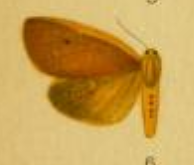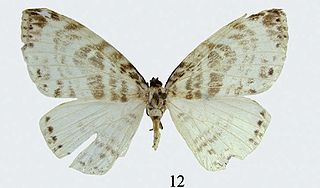Rhimphaliodes is a monotypic moth genus of the family Crambidae described by George Hampson in 1893. Its only species, Rhimphaliodes macrostigma, described by the same author in the same year, is found in Sri Lanka, on Borneo and in Australia, where it has been recorded from Queensland.
Mnesiloba intentata is a moth of the family Geometridae first described by Francis Walker in 1866. It is known from Borneo, Java, Peninsular Malaysia, Luzon and New Guinea. The species was cited by George Hampson that, it is also found in Sri Lanka, but recent observations from the country reject the presence of the species from Sri Lanka.

Spilosoma gynephaea is a moth in the family Erebidae. It was described by George Hampson in 1901. It is found in South Africa and Zimbabwe.

Spilosoma latiradiata is a moth in the family Erebidae. It was described by George Hampson in 1901. It is found in South Africa and Zambia.
Glaucocharis minutalis is a moth in the family Crambidae. It was described by George Hampson in 1893. It is found in Sri Lanka.
Apilocrocis glaucosia is a moth in the family Crambidae. It was described by George Hampson in 1912. It is found in Panama, Guatemala and Mexico.
Azochis rufidiscalis is a moth in the family Crambidae. It was described by George Hampson in 1904. It is found in the Bahamas, Hispaniola, Puerto Rico, Cuba and the south-eastern United States, where it has been recorded from Florida.
Pycnarmon nebulosalis is a moth in the family Crambidae. It was described by George Hampson in 1896. It is found in Sri Lanka.
Sufetula rectifascialis is a moth in the family Crambidae. It was described by George Hampson in 1896. It is found in Sri Lanka.
Syllepte parvipuncta is a moth in the family Crambidae. It was described by George Hampson in 1912. It is found in Ghana and Sierra Leone.
Syllepte attenualis is a moth in the family Crambidae. It was described by George Hampson in 1912. It is endemic to Kenya.
Syllepte disticta is a moth in the family Crambidae. It was described by George Hampson in 1912. It is found in Papua New Guinea.
Syllepte eriopisalis is a moth in the family Crambidae. It was described by Francis Walker in 1859. It is found on Borneo and in India.
Amphitorna albipuncta is a moth in the family Drepanidae. It was described by George Hampson in 1893. It is found in Sri Lanka.
Drepana rufofasciata is a moth in the family Drepanidae. It was described by George Hampson in 1893. It is found in Sikkim in India and Tibet in China.
Paralbara perhamata is a moth in the family Drepanidae. It was described by George Hampson in 1892. It is found in Northeast India including Sikkim and in Borneo.
Euparyphasma albibasis is a moth in the family Drepanidae first described by George Hampson in 1893. It is found in India, Taiwan and China.

Cyclidia pitmani is a moth in the family Drepanidae. It was described by Frederic Moore in 1886. It is found in Myanmar and Yunnan, China.
Pseudojana pallidipennis is a moth in the family Eupterotidae. It was described by George Hampson in 1895. It is found in Myanmar and the north-eastern Himalayas.
Moca purpurascens is a moth in the family Immidae. It was described by George Hampson in 1893. It is found in India.


